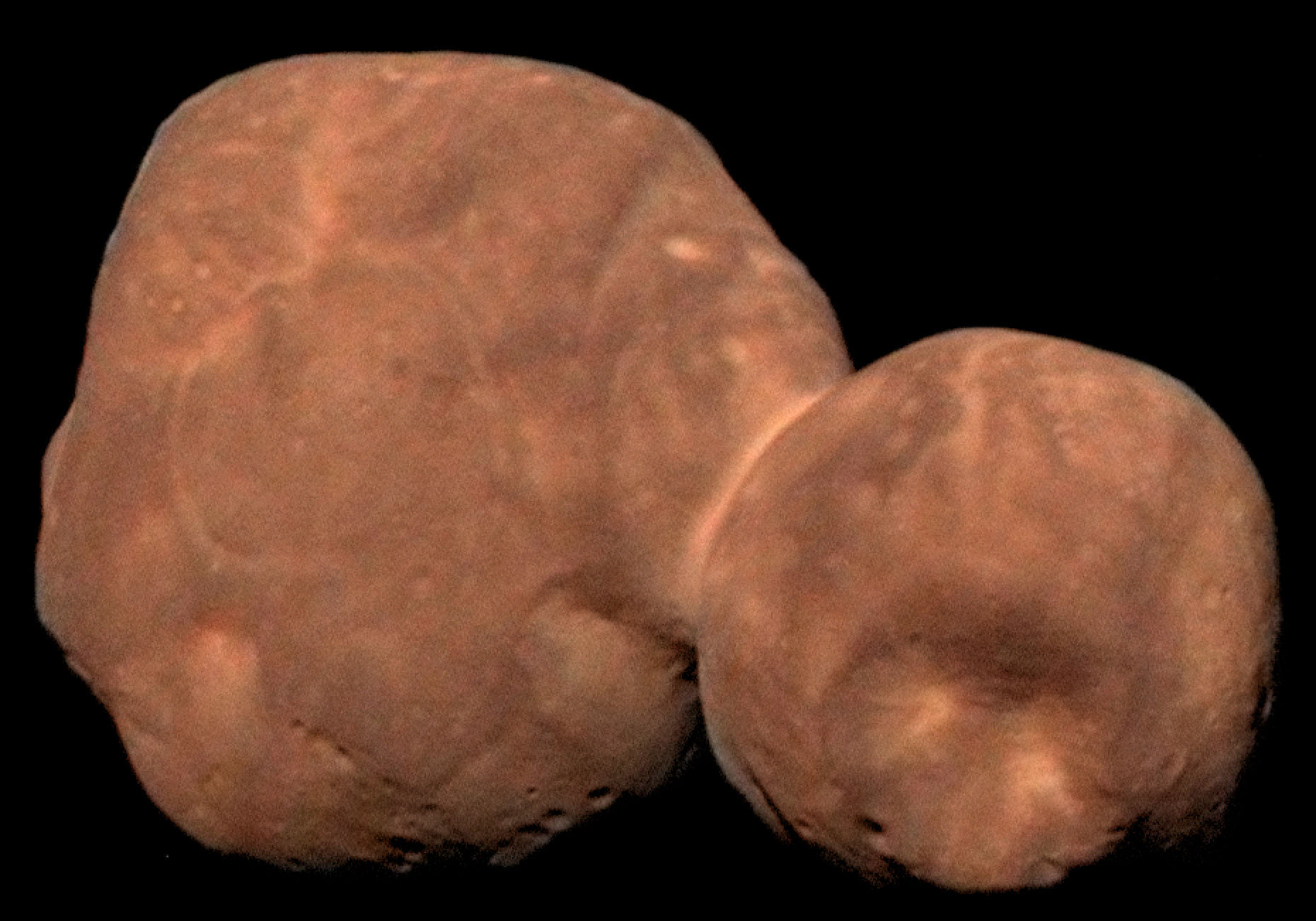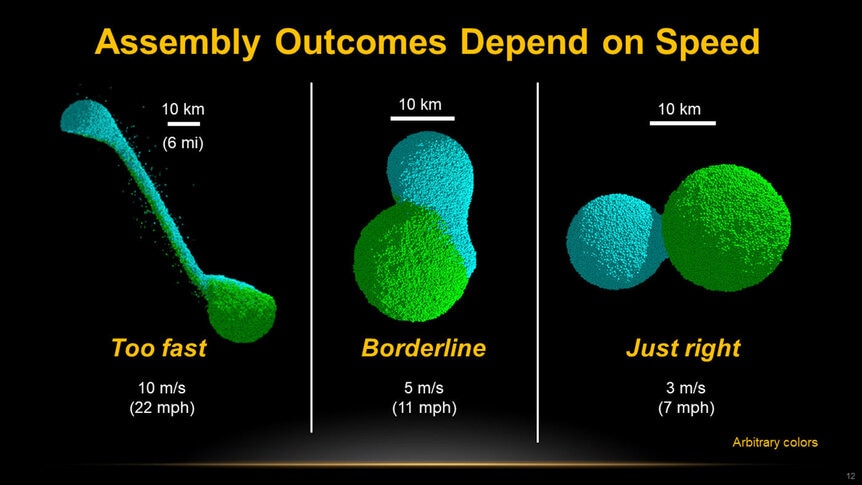Create a free profile to get unlimited access to exclusive videos, sweepstakes, and more!
How to build a Kuiper Belt Object: Arrokoth's two halves formed separately and slowly came together

On January 1, 2019 — just three and half years after it passed Pluto — the new Horizons spacecraft zipped past the Kuiper Belt Object called (at that time) 2014 MU69. We knew a little about it before the encounter, like that it traveled around the Sun in a fairly circular path 6.6 billion kilometers away, and that it was either a binary object or bilobed; two objects connected together like the comet 67P.
But then New Horizons sailed past it at a distance of only 3,500 kilometers — after traveling more than 6 billion — and we learned a lot more.
Now, a year later, after examining the copious data sent back across the black, scientists have published a trio of papers examining the object now known as Arrokoth. What they found can be summed up succinctly, if perhaps too simply: It’s extremely red, it has very few craters on a smoothish surface, and perhaps most importantly it formed slowly and gently, likely from two separate objects that coalesced.
Let’s take those in that order.
A lot of objects out past Neptune, in what we call the Kuiper Belt, are red. In many cases it's because they’re covered in organic materials called tholins that are reddish. But in this case they took spectra, breaking the light up into individual colors, in order to identify specific chemicals. What they found is that there is almost no water on the surface, but there is quite a bit of… methanol. Yup. The kind of alcohol that you can't drink.
There are two possible ways that may have come to be. One is that there was a lot of carbon monoxide (CO) ice on the surface, and over time it mixed with hydrogen, forming methanol. That’s possible, but a more likely path is that there used to be methane and water ice on the surface, and constant bombardment by cosmic rays (subatomic particles zipping around at near the speed of light) transmogrified them into methanol. That would explain the lack of water seen.
That methanol, plus some other molecules they haven’t able to ID yet, are why Arrokoth looks so red. Spectra of other Kuiper Belt Objects (KBOs) show they lack water ice as well, so this may be a common feature out there.
The surface itself tells us a lot about Arrokoth's past, too. It has one largish crater, called Maryland (the New Horizons probe was managed by Applied Physics Laboratory at Johns Hopkins University in that state), which is about 7 kilometers wide. All the other craters seen were 1 km in diameter or less, and the surface outside those is pretty smooth.
The lack of craters was expected. Long ago, when the solar system was very young, a disk of gas and dust and debris circled the Sun. As Neptune formed, it rammed through this junk and moved outward from the Sun, out to about 4.5 billion kilometers out, scattering debris chunks into elliptical and tilted orbits. But farther out, from 6–8 billion kilometers from the Sun, things were much calmer. Material there tended to lie in the plane of the flat disk, with circular orbits.
So while Pluto, closer in to the Sun and on a tilted orbit, was able to get whacked by other objects, Arrokoth was spared. Given the amount of material out there and the density of craters on its surface (the number of craters divided by the surface area of Arrokoth), planetary scientists can tell that the surface is very old, at least 4 billion years. That also was expected. While Pluto is big enough to be dynamic and sometimes wells up material from the interior that repaves the surface and covers up craters, Arrokoth isn't. What you see here is what you get. The surface hasn't changed appreciably since the solar system was very young.
But the most obvious thing about Arrokoth is that weird shape, like a peanut someone stepped on. It has two lobes, one twice the volume of the other, and they're flattened. At first it was thought they were really flat, but better data that eventually came back from New Horizons showed that they aren’t as flat as all that.
The big lobe is 20.6 × 19.9 × 9.4 km in size, and the smaller one is 15.4 × 13.8 × 9.8 km. The smaller one is actually a bit thicker than the big one, too. Overall the length of Arrokoth is 36 km.
The two lobes are connected by a thin neck, and that turns out to be important. There’s no evidence of compression at the neck, like you might expect if the two lobes formed separately and impacted rather hard. This implies they contacted each other rather gently, probably at only a few meters per second.
Scientists ran a series of computer models, starting with two differently sized objects, and let them impact at different velocities and angles. At too high a velocity the impact caused a lot of material to shear off, and the two objects don't stay together. At lower speeds (about 5 meters per second, somewhere between a jog and a sprint), the two can connect, but the neck is thick, and material sloshes around to distort the overall shape.
But at a lower speed (3 m/s) and a very oblique angle of 80° (where 0° is head-on, and 90 is a grazing skim), the results they got match the shape. That is incredibly unlikely for two objects that formed in very different places and came together after an impact. Instead, it implies strongly that these two formed together as a binary object and eventually merged.
The idea is that they both coalesced from a cloud of pebbles (rocks from millimeter in size to a few decimeters), as two distinct but close-by objects orbiting each other. There was still lots of dust and gas around them, and the drag from this would have slowly made them spiral together, until they just kissed, forming one object.
Interestingly, their geometry is all aligned. They connected such that their flat sides are at the same orientation (think of it as the two lobes being equator to equator). That may have happened over time when they still orbited one another; the tides from each other’s gravity would eventually align them. They may be flat in the first place due to their rotation as they formed, centrifugal force throwing more material along their equators as they spun. When they merged they kept that overall rotation, too.
All this points toward them forming together and gently merging. Observations of the part of the Kuiper Belt where Arrokoth lives indicates a large fraction of objects there are double-lobed or binary, so this discovery of how Arrokoth got this shape may be expandable to those other objects as well.
Pretty cool. Observe one object, and learn about a whole lot more.
Of course, we have to be careful; this is only one object, so you can’t wildly extrapolate to everything else. But it’s pretty provocative, and the physics of all this is pretty well understood.
We won't know for sure until we examine a bunch more up close. The good news is that the New Horizons mission has been extended through 2021 at least, which can include another close flyby if a suitable object can be found. So stay tuned. This little mission isn't done quite yet.




























